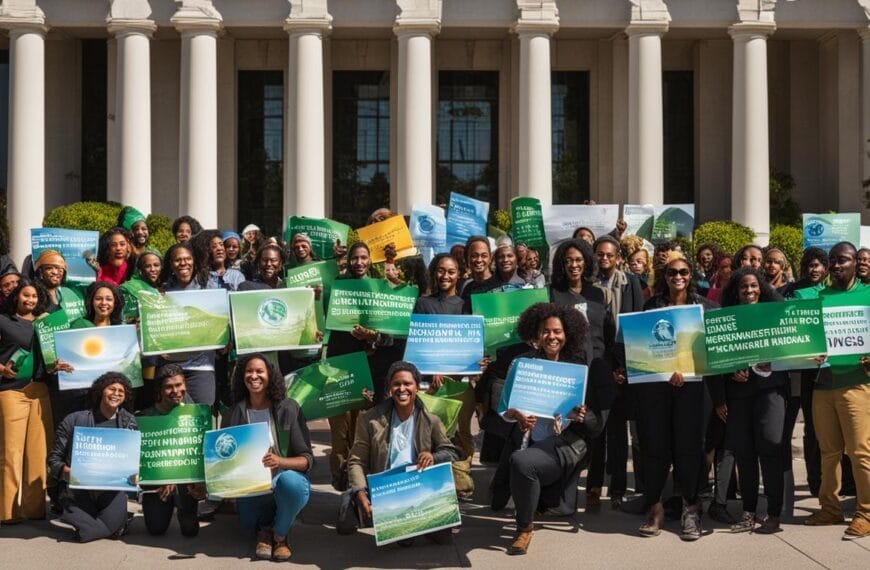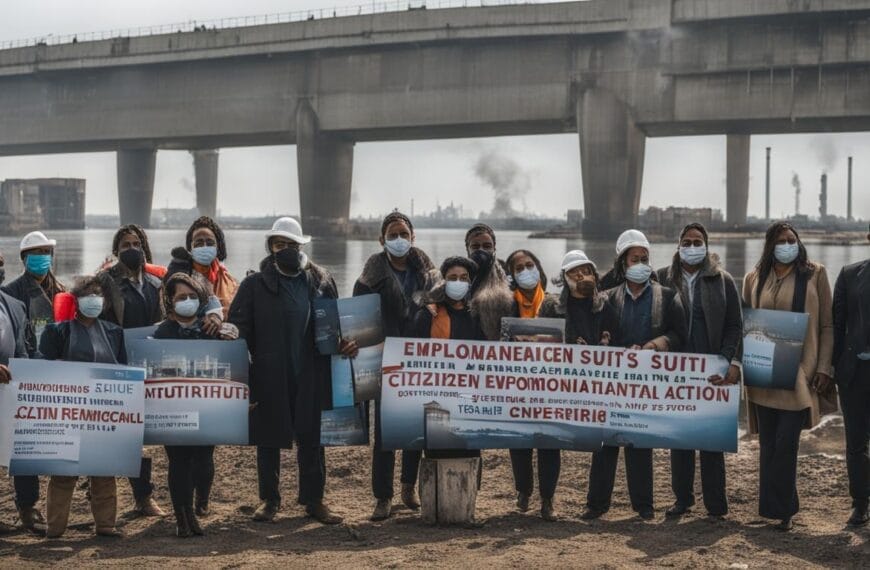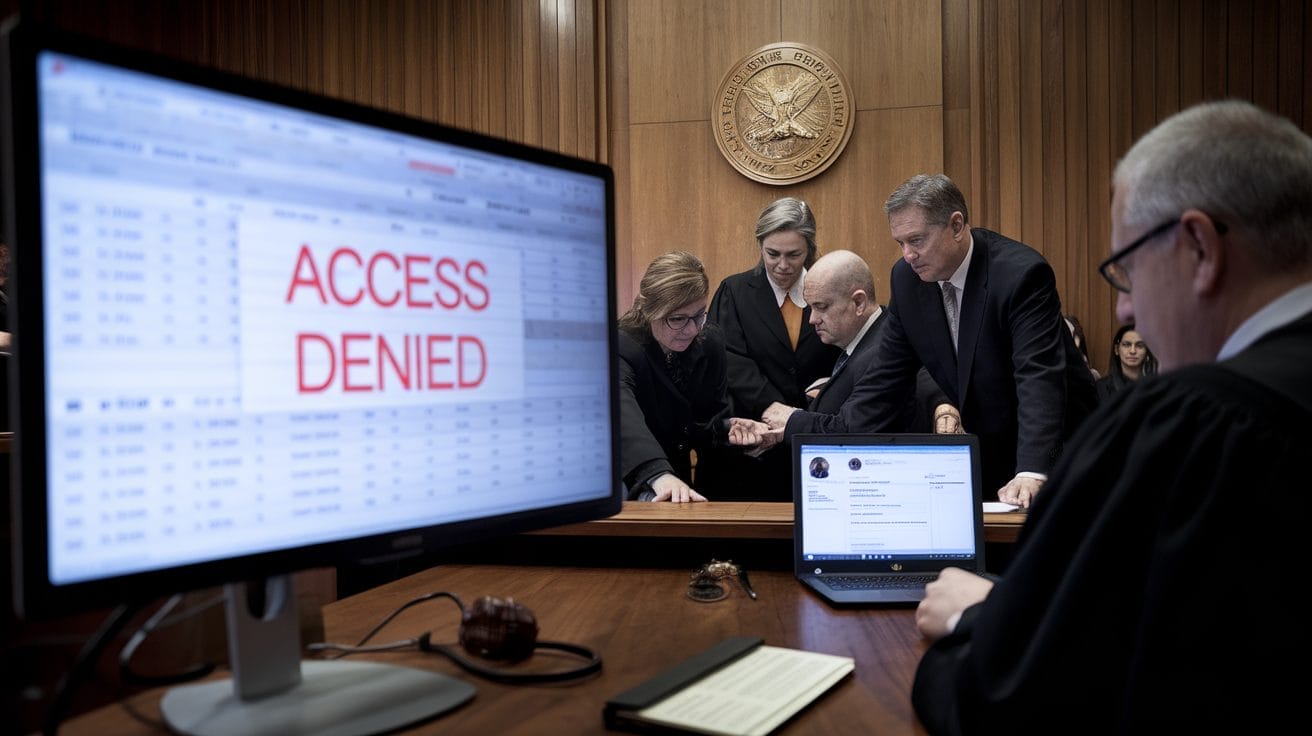Welcome to the Center for Applied Environmental Law and Policy, where we are dedicated to advancing environmental justice and shaping sustainable laws. Our mission is to address the disproportionate impacts of environmental pollution on marginalized communities and promote fair and equitable environmental outcomes. Through innovative programs, policies, and activities, we strive to create a world where every individual has access to clean air, water, and a healthy environment.
Key Takeaways:
- The Center for Applied Environmental Law and Policy is committed to advancing environmental justice
- We focus on addressing the disproportionate impacts of pollution on marginalized communities
- We develop programs, policies, and activities that promote fair and equitable environmental outcomes
- Our work aligns with President Biden’s Executive Order on Tackling the Climate Crisis
- We are dedicated to mobilizing a whole-of-government approach to environmental justice
Mobilizing a Whole-of-Government Approach to Environmental Justice
As part of the President’s commitment to environmental justice, the Center for Applied Environmental Law and Policy is mobilizing a whole-of-government approach. This approach entails a comprehensive and coordinated effort across federal agencies to address the disproportionate impacts of environmental pollution on marginalized communities and ensure a fair and equitable distribution of environmental benefits.
One notable initiative in this endeavor is the Justice40 Initiative, which aims to deliver 40 percent of the overall benefits of climate action, clean energy, affordable housing, clean water, and other investments to underserved communities. By prioritizing the needs of these communities, the Center strives to rectify historical inequities and create a more inclusive and sustainable future.
In order to ensure consistency in the implementation of programs that benefit underserved communities, the Center is also developing a Climate and Economic Justice Screening Tool. This tool will provide agencies with a framework for evaluating the potential impacts of their initiatives and determining how they can effectively address the needs of marginalized communities.
“Environmental justice is not just about addressing the environmental impacts on communities; it is also about rectifying economic and social disparities. Mobilizing a whole-of-government approach allows us to tackle these challenges holistically and create meaningful change.”
The commitment to environmental justice goes beyond government initiatives. The Center recognizes the importance of elevating the voices of marginalized communities in decision-making processes. In line with this commitment, the White House has established the Environmental Justice Advisory Council and renewed its focus on environmental equity and justice across federal agencies. These actions demonstrate the Center’s dedication to ensuring that the needs and perspectives of marginalized communities are taken into account in shaping environmental policies and regulations.
By mobilizing a whole-of-government approach and actively engaging with communities, the Center for Applied Environmental Law and Policy aims to advance environmental justice and create a more sustainable and equitable future for all.
Protecting Communities from Toxic Pollution
The Center for Applied Environmental Law and Policy is actively working towards protecting communities from the harmful effects of toxic pollution. Implementing science-based regulations and strengthening enforcement of environmental laws are key measures taken by the Center to reduce the adverse health impacts faced by marginalized communities. By revoking the usage of harmful pesticides and taking action against dangerous chemicals such as per- and polyfluoroalkyl substances (PFAS), the Center aims to mitigate the risks of toxic pollution.
In addition, the Center is focused on improving air quality through targeted interventions. This includes identifying sources of pollution, implementing emission controls, and promoting sustainable practices. By addressing legacy pollution, such as Superfund and brownfield sites, abandoned mine lands, and orphaned oil and gas wells, the Center aims to eliminate sources of blight and pollution that disproportionately affect underserved communities.
Through collaborative efforts with government agencies, community organizations, and industry stakeholders, the Center for Applied Environmental Law and Policy strives to create a cleaner and healthier environment for all. By holding polluters accountable and advocating for stricter regulations, the Center aims to ensure the long-term protection of communities from toxic pollution.
| Actions to Protect Communities from Toxic Pollution | Impact |
|---|---|
| Revoking usage of harmful pesticides | Reduces exposure to toxic chemicals in communities |
| Taking action on dangerous chemicals like PFAS | Minimizes health risks associated with these substances |
| Improving air quality through targeted interventions | Reduces respiratory illnesses and improves overall health |
| Addressing legacy pollution through cleanup efforts | Eliminates sources of pollution in underserved communities |
Quote:
“Our commitment to protecting communities from toxic pollution drives our efforts to strengthen environmental regulations and enforcement. By holding polluters accountable, we can create clean and healthy environments for all.” – [Name], Director of Environmental Policy Development at the Center for Applied Environmental Law and Policy.
Advancing Environmental Justice Through Community Engagement
The Center for Applied Environmental Law and Policy is dedicated to promoting community engagement and empowering marginalized communities in decision-making processes. By providing access to legal services and childcare, we ensure that all communities have a voice in environmental justice issues.
Our educational initiatives aim to familiarize communities with environmental concerns and inform them of their environmental rights affected by infrastructure development. We believe that early community involvement and alternative identification are crucial in ensuring equitable outcomes.
We are establishing information and notice requirements to enhance transparency and inclusivity in environmental decision-making, giving communities the opportunity to actively participate in shaping their environmental futures.
Importance of Community Engagement
Community engagement plays a vital role in the advancement of environmental justice. By involving communities affected by environmental issues, we gain valuable insights into the unique challenges they face.
Engagement fosters a sense of ownership as communities become active stakeholders in shaping environmental policies and initiatives. It leads to more sustainable solutions by incorporating local knowledge, cultural considerations, and community priorities into decision-making processes.
“Community engagement is the cornerstone of environmental justice. By empowering communities and centering their voices, we can create a more just and sustainable future for all.”
The Power of Education
Education is key to building awareness and empowering communities to advocate for their environmental rights. Through workshops, webinars, and educational resources, we equip individuals with the knowledge they need to actively participate in environmental decision-making processes.
By understanding the environmental impacts on their communities, residents can confidently engage with government agencies, advocate for themselves, and hold decision-makers accountable.
Breaking Barriers for Community Participation
We recognize that certain barriers hinder community participation in environmental justice initiatives. To address these challenges, we provide access to legal services to ensure equitable representation and offer childcare services to enable in-person participation.
This commitment to breaking barriers encourages diverse voices to be heard and fosters a sense of inclusivity within the environmental justice movement.
| Benefits of Community Engagement | Actions for Effective Community Engagement |
|---|---|
|
|
Expediting Renewable Energy Siting for Environmental Justice
The Center for Applied Environmental Law and Policy recognizes the need to prioritize the siting of renewable energy projects with a strong focus on environmental justice. However, various challenges, including frivolous lawsuits and state-wide renewable energy targets, often hinder the timely development of such projects in underserved communities.
To overcome these challenges and expedite the process, the Center advocates for the utilization of environmental justice mapping tools during the planning stage. These tools help identify suitable locations that not only maximize environmental benefits but also ensure social equity.
By streamlining the siting process and addressing the challenges associated with it, the Center aims to accelerate the deployment of renewable energy projects in marginalized communities. This expedited process will not only contribute to a cleaner and more sustainable future but also promote environmental justice by ensuring that underserved communities have equitable access to the benefits of clean energy.
Benefits of Expediting Renewable Energy Siting for Environmental Justice
- Increased access to clean energy for marginalized communities.
- Reduction in greenhouse gas emissions, leading to improved air quality and public health outcomes.
- Creation of local job opportunities and economic growth in underserved areas.
- Enhanced energy resilience in vulnerable communities.
- Promotion of community engagement and empowerment throughout the siting process.
By expediting renewable energy siting, the Center strives to address the historical injustices faced by marginalized communities and pave the way for a more sustainable and equitable future.
Leveraging Federal Sustainability Initiatives for Environmental Justice
The Center for Applied Environmental Law and Policy recognizes the importance of leveraging federal sustainability initiatives to advance environmental justice. By reducing emissions across federal operations and investing in American clean energy industries, the Center aims to create clean, healthy, and resilient communities.
The Center supports federal policies that promote equitable access to clean energy, eliminate environmental disparities, and address the impacts of climate change. Through collaboration with federal agencies and implementation of the Energy and Infrastructure Provisions of the Inflation Reduction Act, the Center strives to achieve environmental justice goals and ensure a just transition to a sustainable future.
One of the key aspects of leveraging federal sustainability initiatives is the reduction of emissions across federal operations. By implementing cleaner practices and technologies, federal agencies can set an example for other industries and promote sustainable practices. This reduction in emissions not only contributes to fighting climate change but also improves air quality and public health in communities affected by pollution.
“By reducing emissions across federal operations and investing in American clean energy industries, the Center aims to create clean, healthy, and resilient communities.”
Furthermore, investing in American clean energy industries not only helps in achieving federal sustainability goals but also fosters economic growth and job creation. By supporting the development and deployment of renewable energy technologies, the Center promotes the transition to a clean energy economy that benefits both the environment and local communities.
Through collaboration with federal agencies, the Center ensures that environmental justice considerations are integrated into decision-making processes. By providing guidance, expertise, and advocacy, the Center helps federal agencies prioritize equitable access to clean energy and address environmental disparities that disproportionately impact marginalized communities.
Advantages of Leveraging Federal Sustainability Initiatives:
- Promotes cleaner practices and technologies
- Reduces emissions and improves air quality
- Fosters economic growth and job creation
- Supports the development and deployment of renewable energy
- Integrates environmental justice considerations into decision-making processes
| Initiative | Objectives | Outcome |
|---|---|---|
| Clean Energy Investment | Invest in renewable energy projects | Promote clean energy transition and job creation |
| Environmental Infrastructure Improvements | Upgrade infrastructure to reduce pollution | Improve environmental quality in disadvantaged communities |
| Research and Development Funding | Support innovative clean energy technologies | Drive technological advancements and economic competitiveness |
Enhancing Environmental Justice Through Federal Actions
The Center for Applied Environmental Law and Policy recognizes the vital role that federal actions play in enhancing environmental justice. In particular, the Environmental Protection Agency (EPA) is at the forefront of advancing environmental justice through various initiatives and processes.
The EPA is committed to ensuring national compliance with environmental regulations, which helps protect all communities, especially those historically burdened by pollution. By enforcing these regulations, the EPA aims to hold polluters accountable and prevent further harm to the environment and public health.
Moreover, the EPA understands the unique challenges faced by Indigenous communities and actively engages in consultation and coordination with them to address environmental concerns. By working collaboratively with Indigenous communities, the EPA acknowledges their rights to a clean and healthy environment, ensuring their voices are heard in decision-making processes.
To integrate environmental justice into various permitting processes, the EPA’s strategic plan focuses on historically overburdened and underserved communities. By considering the potential impacts of proposed projects, the agency aims to prevent further environmental inequalities and address the disproportionate burdens faced by marginalized communities.
Promoting meaningful engagement
“Environmental justice is not just about creating equitable outcomes. It is about creating an equitable process.”
The Center for Applied Environmental Law and Policy emphasizes the importance of meaningful engagement with affected communities. By promoting transparency and inclusivity in decision-making, federal actions can ensure that the concerns and perspectives of marginalized communities are given due consideration.
Through enforcement actions and civil rights statutes, the Center aims to empower affected communities to hold polluters accountable for any harm caused. By giving communities a voice and legal tools to seek justice, environmental justice can be achieved.
Center for Applied Environmental Law and Policy’s commitment
“We believe in a future where everyone has the right to breathe clean air, drink clean water, and live in a healthy environment. Through our work, we aim to achieve this vision of environmental justice for all.”
Table: Environmental Justice Achievements through Federal Actions
| Action | Description |
|---|---|
| National Compliance Initiatives | Enforcement actions to ensure compliance with environmental regulations |
| Consultation and Coordination with Indigenous Communities | Engagement with Indigenous communities, respect for their rights, and addressing their environmental concerns |
| Integration of Environmental Justice into Permitting Processes | Consideration of environmental justice concerns during the permitting of projects |
| Transparency and Inclusivity | Promotion of meaningful community engagement and public participation |
| Legal Tools for Accountability | Enforcement actions and civil rights statutes to hold polluters accountable |
By leveraging federal actions, the Center for Applied Environmental Law and Policy aims to create a more just and sustainable future for all communities, ensuring equitable environmental outcomes and protecting the rights of marginalized populations.
Conclusion
The Center for Applied Environmental Law and Policy is at the forefront of the fight for environmental justice and the shaping of sustainable laws. By adopting a comprehensive whole-of-government approach, actively engaging communities, expediting renewable energy siting, and leveraging federal sustainability initiatives, the Center is committed to addressing the disproportionate impacts of environmental pollution on marginalized communities.
Through its dedication to protecting communities from toxic pollution and advancing environmental justice through federal actions, the Center aims to create a more just and equitable society. By promoting equitable access to clean energy and advocating for fair environmental policies, the Center strives to ensure that everyone has the opportunity to live in a sustainable and healthy environment.
As we move forward, the Center for Applied Environmental Law and Policy will continue its vital work in environmental justice to shape sustainable laws and policies that result in fair and equitable environmental outcomes. By championing the principles of environmental justice, the Center plays a crucial role in creating a better future for all, where communities are protected, voices are heard, and environmental equality is achieved.
FAQ
What is the mission of the Center for Applied Environmental Law and Policy?
The Center for Applied Environmental Law and Policy is dedicated to advancing environmental justice and shaping sustainable laws.
What is a whole-of-government approach to environmental justice?
A whole-of-government approach involves the mobilization and coordination of multiple government agencies to address environmental justice issues.
How does the Center protect communities from toxic pollution?
The Center works to implement science-based regulations and strengthen enforcement of environmental laws to reduce the adverse health impacts of pollution on marginalized communities.
What initiatives does the Center undertake to advance environmental justice through community engagement?
The Center facilitates access to legal services, provides childcare services for in-person participation, and implements educational initiatives to empower communities and ensure their voices are heard in environmental justice issues.
How does the Center expedite renewable energy siting for environmental justice?
The Center advocates for the use of environmental justice mapping tools to identify suitable locations for renewable energy projects in underserved communities, streamlining the siting process.
How does the Center leverage federal sustainability initiatives for environmental justice?
The Center supports federal policies that promote equitable access to clean energy, reduce emissions across federal operations, and invest in American clean energy industries to create clean, healthy, and resilient communities.
How does the Center enhance environmental justice through federal actions?
The Center collaborates with federal agencies, utilizes legal tools like enforcement actions and civil rights statutes, and works to integrate environmental justice into permitting processes, protecting historically overburdened and underserved communities.
What is the role of the Center in advancing environmental justice?
The Center for Applied Environmental Law and Policy is dedicated to advancing environmental justice and shaping sustainable laws to ensure fair and equitable environmental outcomes for all.













